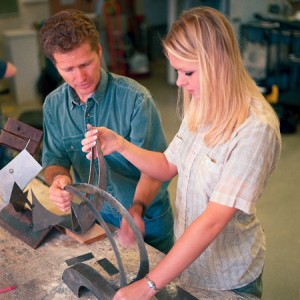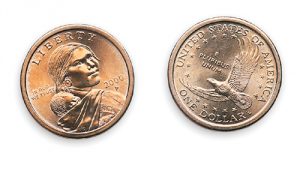
The new BYU Annual Fund is designed to increase BYU’s effect on the world-one donor, one professor, on student at a time.
By M. Sue Bergin, ‘79
IN A MEMORABLE SCENE FROM THE 1946 FILM IT’S A WONDERFUL LIFE, GEORGE BAILEY CEREMONIOUSLY PLACES HIS LAST TWO DOLLARS IN THE BUILDING AND LOAN’S SAFE AND SAYS HE WISHES THEY COULD MULTIPLY LIKE RABBITS.
“A toast to Papa Dollar and to Mama Dollar,” he says. “You better have a family real quick.”
Dollar bills are not rabbits, of course. But for BYU donors currency propagation is more than just a wish. The new 40-member President’s Leadership Council has promised to match every dollar an alum contributes to unrestricted funds in the year 2001, dollar for dollar up to $25,000. For recent bachelor’s degree recipients (in the last 5 years), they’ll match donations 2 to 1. And for student donors they’ll match every dollar an extraordinary 5 to 1.
“This is an unprecedented and extremely generous offer,” says BYU president Merrill J. Bateman. “I hope every alumnus, every student, every employee, and every friend of BYU will take this exceptional opportunity to donate and have their contribution augmented.”
The matching-fund donors have put up a total of $5 million. Their aim is to help the university kick-start a fresh approach to fund-raising, called the BYU Annual Fund, that centralizes requests and encourages those spending the funds to report back to donors.
“This is a coordinated effort that will bring most of the university’s mass solicitation programs under a single umbrella,” says K. Fred Skousen, ’65, advancement vice president.
With the anticipated rise in donations, BYU will be able to award more faculty-student mentorships for undergraduates, strengthen all undergraduate programs, and provide funding for President Bateman and the deans to accomplish priorities approved by the board of trustees. “When a donor is generous with us, it allows us to move more rapidly,” says Elder Henry B. Eyring, a member of the board of trustees, an apostle, and the commissioner of education for The Church of Jesus Christ of Latter-day Saints. “The Church has enough resources to do what it needs to do, but because we are doing so many things, we have to do some things more slowly. What would be done in five years could be done in two years. So I would say to potential donors, there are things that the Brethren want done. You can help us go more rapidly. Would you help us?”
“When a donor is generous with us, it allows us to move more rapidly,” says Elder Henry B. Eyring, a member of the board of trustees, an apostle, and the commissioner of education for The Church of Jesus Christ of Latter-day Saints. “The Church has enough resources to do what it needs to do, but because we are doing so many things, we have to do some things more slowly. What would be done in five years could be done in two years. So I would say to potential donors, there are things that the Brethren want done. You can help us go more rapidly. Would you help us?”
The new plan—and the matching funds—have already proven to be an inspiration. In April elementary education associate professor Nancy Brockbank Livingston, ’75, had one of her classes read a children’s book about Sacagawea, the Shoshone woman who was indispensable in helping Lewis and Clark explore the West. In 2001 the U.S. Treasury recognized Sacagawea with a new one-dollar coin, and Livingston saw the coin as an ideal visual aid to illustrate “the power of one,” the slogan for the new Annual Fund. During a session of Elementary Education 356, she gave each of her 28 students a Sacagawea coin. Like Sacagawea, she explained, they could make a difference as just one individual.
“Fund-raising is so difficult, and philanthropy is a mindset that has to be taught early and gently,” says Livingston. “I told them, ‘You can turn that one dollar into five more dollars just by donating it to the university.'” All of them did just that—though most pocketed the striking coin and donated a paper dollar instead.
ALUMNI NEEDED
The men and women donating the $5 million, many of whom are not BYU graduates, hope the matching fund will send a message to alumni—that BYU needs them, both for their donations and for the vote of confidence their donations represent.
“Though I’m not a BYU graduate, I feel as strongly about supporting BYU as I do my alma mater, West Point, because of the role BYU plays in building the kingdom of God,” says Jack Wheatley, cochair of the President’s Leadership Council. “Many BYU graduates are financially blessed, and we hope they will see what is needed and step up to the bar.”
If you’re an alum, you’ve probably already received at least one mailing under this new program, but you may not have realized that it represents a major change in how BYU raises money. You can be assured that any contact you receive is a carefully coordinated, unified effort backed by the university’s administration and board of trustees.* And you will know that every dollar you send in, up to $25,000, will be matched as long as you designate one or more of three unrestricted funds: University Priorities, General Scholarships, and the Deans’ Discretionary Fund.
With more monies that don’t have strings attached, President Bateman and the deans can direct funds to areas where the need is greatest.
“People tend to want to restrict their donation to a specific cause, thinking they’re going to do a great amount of good,” says Linda M. Palmer, ’71, director of Annual Giving. “And although such donations are always appreciated, sometimes we don’t get enough to make a difference in that specific area. In order get a bigger wallop, we’re bringing the fund-raising under the direction of the president, deans, and board of trustees. They know where the highest priorities are.”
The board of trustees is chaired by Church President Gordon B. Hinckley, who has emphasized that BYU has an important role in the Church. He has also said that every donation makes a difference. “You never can foretell the consequences of a dollar invested in education,” President Hinckley said in 1996. “It goes on multiplying itself. It becomes not an expenditure but an investment that pays returns far and wide and through generations to come.”
One of the top priorities the board of trustees has set is mentorship between students and faculty (see “Students and the Search for Truth,” p. 3). The board wants more students to have one-on-one experiences with faculty, says Skousen.
“The experience of working closely with a professor is priceless. This is commonly done on the graduate level, but we want many more undergraduates to have this opportunity. We need financial aid for students and research stipends for faculty so they can work together and improve the learning process,” he says.
STEWARDSHIP AND ACCOUNTABILITY
Colleges and departments have always received money from BYU‘s annual solicitations, but such contributions were lumped together with money from the Church and from tuition. This year for the first time, President Bateman disbursed funds to deans directly from the Annual Fund. With Annual Fund monies distributed separately from budget allocations, the administration believes the impact of donations will be clearer—to both the donors and the recipients. And with the ability to report back to donors how their money is spent, deans can focus on “friend-raising” instead of fund-raising. “We want to hear the stories. Were you able to award more scholarships? And what happened to those young people who got those scholarships?” says Palmer. “It’s a wonderful thing to communicate back with the donors. They want to know, ‘Did my five dollars do anything?'”
“We want to hear the stories. Were you able to award more scholarships? And what happened to those young people who got those scholarships?” says Palmer. “It’s a wonderful thing to communicate back with the donors. They want to know, ‘Did my five dollars do anything?'”
Deans are also being asked to tell students which scholarships, program enhancements, and equipment were funded by Annual Fund donations.
“We want students to recognize the significant impact donations have on the quality of their experience at BYU. Our hope is that as they develop this appreciation, they will become donors while they are still students and resolve to continue donating when they become alumni,” says Palmer.
K. Newell Dayley, ’64, dean of the College of Fine Arts and Communications, plans to use a significant portion of his Annual Fund disbursements for mentoring. “We’ve had mentored environments in the arts forever—it’s one of the ways we teach. So far we’ve done as well as anybody else, but these funds will allow us to do it with distinction.”
Dayley is ardent in his support of the Annual Fund because, he says, it brings all the university’s disparate programs together rather than having each compete for its piece of the fund-raising pie.
“This is the best thing that’s happened to the university in the past 125 years,” says Dayley. “To have one approach is so important. We’re really unified as a campus now. I believe this feeling will carry to our alumni and friends. They will sense this unity and respond in kind.”
Like Dayley, each dean of the university’s 11 colleges and schools has ambitious plans for the increased funding they hope to garner. The College of Humanities, for example, wants to endow a Center for Language Studies. Dean Van C. Gessel expects the center to “teach advanced courses that will upgrade language skills beyond missionary-level to a polished status appropriate for diplomatic, government, business, and professional settings.”
The College of Nursing wants to provide scholarships for at least 20 students per year to have an international experience in nursing care. “These experiences instill graduates with deep compassion, provide broad world experience, and introduce them to unique health issues rarely seen in the United States,” says Dean Elaine S. Marshall. “They immeasurably augment our graduates’ skills and career opportunities.”
SETTING THE PATTERN EARLY
The university has rarely asked students to donate, assuming they are struggling just to pay tuition. But with the 5-to-1 match for students, even the smallest contribution becomes significant. And students who make a habit of contributing when they are least able are more likely to continue contributing as their means increase. Thus students are included in the Annual Fund’s efforts.
“It’s always helpful for the larger outside donors when they’re told that the students are helping. It’s easier to want to help people who are givers,” says Elder Eyring. “Also, when students give they have a wonderful experience early in their life of being generous and of giving back—’My parents, the Church, the university, have given, and I am eager to give back.’ If it starts early in a person’s life, it’s an attitude that they learn for the rest of their lives. So it’s this attitude much more than the money. That’s why we ask, ‘Give anything—just give something—because it suggests that you recognize a debt and that you would like to give back.'”
So far, students have responded with enthusiasm. When leaders of the Student Alumni Network, Brandon M. Lee, ’01, and David A. Johnson, ’03, heard about the 5-to-1 match, they asked if they could run a weeklong drive on campus.
“It wasn’t something the administration initiated—they came to us and said, ‘This is something we would like to do,'” says Skousen.
With the help of Kyle W. Tresner, ’96, associate director of Annual Giving, and Laurie Wilson, ’80, then the chair of the Communications Department, the students placed ads in the Daily Universe, had President Bateman send a letter to all students, came up with a bright-yellow button that said, “Choose to Give,” and distributed a flyer that read, “Do the math—one equals six.” The results so far have been impressive—nearly $77,000 before matching funds were applied.
ACCELERATING THE PACE
As is so often the case at BYU, at the center of fund-raising is a spiritual core.
“BYU serves thousands upon thousands as it helps to build the kingdom of God on Earth,” wrote President Bateman in a personal appeal to alumni published in the winter 2000–2001 issue of Brigham Young Magazine. “It is my personal belief that this university is an integral part of Zion and will share in her final triumph. We must accelerate the pace at which we become what we should be.”
Accelerating the pace requires financial support, and the beauty of a matching program is that even those who are able to give only a little can know that their offering will be augmented, says Palmer.
“A small amount—one person giving to one fund—can make one incredible difference because it multiplies and magnifies and goes on helping people for generations to come.”
Related Article: WANTED: True Blue Alumni Donors
Sue Bergin is a writer and editor in American Fork, Utah.
info: For more information or to give to the BYU Annual Fund, call 1-800-525-8074, send e-mail to annualfund@byu.edu, or visit annualfund.byu.edu.
*Although most solicitations will be consolidated under the Annual Fund, a few programs, such as Cougar Club and KBYU, will continue to solicit separately.






